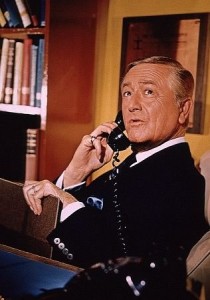 Laurence Bauer has been an ardent, longtime advocate of family medicine. Among other things, he is Chief Executive Officer of the Family Medicine Education Consortium, a not-for-profit corporation that encourages and supports collaboration among Family Medicine Residency Programs and Departments of Family Medicine.
Laurence Bauer has been an ardent, longtime advocate of family medicine. Among other things, he is Chief Executive Officer of the Family Medicine Education Consortium, a not-for-profit corporation that encourages and supports collaboration among Family Medicine Residency Programs and Departments of Family Medicine.
Larry and I met thanks to our mutual interest in Marcus Welby, MD. The practice of medicine has changed dramatically since Dr. Welby inspired doctors to become practitioners of family medicine. Yet each time I talk to Larry, I’m reminded of today’s dedicated students and physicians who want to practice comprehensive care with the same concern for the whole person that Welby expressed for his patients. This remains a timeless value of the medical profession, and for Larry, it’s important to keep that value alive in an age of narrow subspecialties and corporate medicine.
Family Medicine as a specialty (a three-year residency after medical school that includes the study of internal medicine, pediatrics, obstetrics-gynecology, psychiatry, and geriatrics) emerged in the late 1960s. Those who initially endorsed family medicine wanted to change the direction of medical culture and influence its future. In the words that follow, Larry addresses those early visionaries. I’d like to thank him for allowing me to share his thoughts.
The Dreams of the Founders of Family Medicine
When poetry strays too far from music, it atrophies. When music strays too far from dance, it atrophies – Ezra Pound
As Family Practice emerged from the field of General Practice, it is important to realize that many in and out of medicine told the founders they would not succeed. The cynics believed that the dominant forces in medicine were too entrenched and there were too many societal forces working against the idea of a generalist renaissance in medicine. “Real” medicine of the future aspired to something more worthy. Real medicine involved care of hospitalized patients and was informed by the scientific and technological advances associated with sub-specialty medicine. Anyone could care for the people “out there”. But the founders dreamed big, bold dreams; they were a determined and visionary group.
They dreamed of a cadre of talented and competent Family Physicians that would serve the people in all the communities of our nation. The rich, the poor and all in between in rural, urban and suburban communities; all needed access to a well trained Family Physician. They believed that the practitioners in this specialty would focus on the needs of their patients and communities and would protect people from the medical industrial complex as much as possible
They dreamed that a new academic specialty would emerge whose core would focus on issues surrounding patient management and the care of the whole person in their community. They believed that medical education was moribund and harmful and in need of a compassionate and thoughtful revitalization.
For the founders, the biomedical model was inadequate. They believed that it is not possible to be effective as a physician without understanding the contextual issues that influence a person’s life. The biopsychosocial model, the power inherent in relationships and the abilities and skills involved in creating facilitative relationships needed to be integrated into medical education, practice and scholarship.
While they were mindful of and grateful for the powerful advances in medicine, they believed that social and economic conditions which influenced the life of a person and a community had a greater impact on a person’s life and health than did the power and might of all of medicine.
They believed that medicine was a profession that involved more than a technical set of skills and a high income. They accepted the responsibility of caring for the whole person; mind, body and soul.
They believed that the practice of medicine required team work among the medical and helping professionals and that the patient was to be an active partner in the care process. In fact, it is the patient’s goals and agendas that drive the healing process.
They believed that life-long learning and the need to continuously upgrade one’s knowledge and skills was critical to the practice of medicine.
They dreamed of generations of leaders who would rise to take their places and extend their efforts.
They believed that Family Medicine was more than another group of medical practitioners. Family Medicine should serve a transformative agenda that changed the academic medical centers and health systems so they would better serve the people and communities.
They were willing to bring other generalist colleagues to their ranks. They respected the pediatricians, especially, who wanted to contribute to Family Medicine’s early development. They sought a relationship with psychiatry and mental health professionals. They had a comfortable relationship with the general surgeons, general internists and all their colleagues who respected the value of a generalist practitioner.
In the days of Marcus Welby, MD, primary care was family medicine. Although much has changed since then, the founders’ vision of how medicine could be practiced remains an ideal for both doctors and patients. It’s easy to feel discouraged and cynical these days and to believe that the medical-industrial complex has overwhelmed the hearts and minds of the medical profession. Yet when I listen to those like Larry Bauer, who still believe in the power of dreams, my hope is always restored.
Related posts:
Marcus Welby vs. the specialists
The doctor/patient relationship: What have we lost?
The art and science of medicine
Physician as lone practitioner
What gets lost in the bureaucratization of medicine
From MD to MBA: The business of primary care


Sorry, comments are closed for this post.